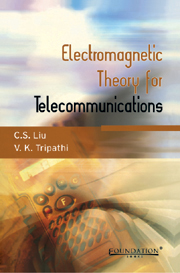Book contents
- Frontmatter
- Contents
- Preface
- 1 Electromagnetic Fields
- 2 Plane Waves
- 3 Guided Waves
- 4 Radiation
- 5 Radio Communication and Radar
- 6 Satellite Communication
- 7 Laser and Optical Fibre Communication
- 8 Geological Seisming and Remote Sensing
- 9 Relativistic Covariance of Electrodynamics
- 10 Radiation from Accelerated Charges
- Appendix A
- Appendix B
- Index
6 - Satellite Communication
Published online by Cambridge University Press: 26 October 2011
- Frontmatter
- Contents
- Preface
- 1 Electromagnetic Fields
- 2 Plane Waves
- 3 Guided Waves
- 4 Radiation
- 5 Radio Communication and Radar
- 6 Satellite Communication
- 7 Laser and Optical Fibre Communication
- 8 Geological Seisming and Remote Sensing
- 9 Relativistic Covariance of Electrodynamics
- 10 Radiation from Accelerated Charges
- Appendix A
- Appendix B
- Index
Summary
Introduction
The information carrying capacity of an electromagnetic wave increases with the frequency of the wave. Hence, microwaves are widely used for voice, video and data transmission. These waves can be transmitted from one Earth station to another as sky waves, using satellite as an active repeater as they suffer optimal diffraction, scattering and absorption losses in one round trip between the Earth and the satellite. The power loss due to diffraction divergence goes as λ2 with the wavelength of the carrier electromagnetic wave, whereas scattering loss goes as λ−4. Hence, microwaves (1-30 GHz) and millimetre waves (30-300GHz) are a good trade off for satellite communication over radiowaves and lasers, if one avoids the frequencies corresponding to vibrational excitations of atoms in the troposphere.
The schematic of an end-to-end satellite communication link is shown in fig. 6.1 It comprises terrestrial links, Earth stations and a geosynchronous satellite repeater, that is stationary with respect to the location of the Earth.
The Terrestrial Link
A terrestrial link processes raw information from the user into a base band signal and transmits it to an Earth station (Fig.6.2). It also performs the reverse role of retrieving information from the signal.
At the first level of processing, a source signal (voice, video, or data) is coded in digital form or processed in analog form. The information is characterised by bandwidth. Consider, for instance, a telephone speech signal generated by converting acoustic signal into an electrical signal using telephone as the transducer. The telephone speech signal is typically band-limited to the frequency range 300 to 3400 Hz and the bandwidth, assigned to a voice channel, is 4 kHz.
- Type
- Chapter
- Information
- Electromagnetic Theory for Telecommunications , pp. 196 - 207Publisher: Foundation BooksPrint publication year: 2007

